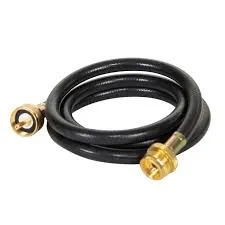335345435
Oct . 18, 2024 15:11 Back to list
High-Performance Steel Wire Hose for Enhanced High-Pressure Applications and Durability
High Pressure Steel Wire Hose An Essential Component in Modern Industries
High pressure steel wire hoses are critical components in various industries, including construction, mining, oil and gas, and manufacturing. These hoses are designed to withstand high pressures and extreme environmental conditions, making them essential for conveying fluids and gases in demanding applications.
Composition and Structure
High pressure steel wire hoses are typically constructed from a combination of synthetic rubber, steel wires, and reinforcement layers. The inner layer is often made from various grades of rubber that provide flexibility and resistance to internal pressures. The steel wire braiding provides structural integrity, allowing the hose to withstand high-pressure environments without collapsing or bursting. The outer layer is also made of durable materials designed to resist abrasion, UV radiation, and chemical exposure.
The number of steel wires and their arrangement (braided or spiral) can vary based on the intended application and the required pressure rating of the hose. Braided steel wire hoses are commonly used for moderate to high-pressure applications, while spiral steel wire hoses are utilized for extremely high-pressure applications due to their ability to handle greater stress.
Applications
High pressure steel wire hoses are essential in a variety of applications. In the oil and gas industry, they are used for drilling operations, transporting hydrocarbons, and in hydraulic systems that require high-pressure fluid transfer. In construction and mining, these hoses are employed in hydraulic machinery, where high-pressure fluid power is necessary for operation.
Moreover, these hoses play a crucial role in the manufacturing sector. They are often used in automated machinery, providing the necessary pressure to operate hydraulic presses, cutting machines, and assembly equipment. Their ability to maintain performance under fluctuating pressures and temperatures makes them reliable components in these high-demand environments.
high pressure steel wire hose

Advantages
One of the main advantages of high pressure steel wire hoses is their durability. The steel reinforcement not only enhances their pressure-handling capabilities but also extends their service life by providing resistance to wear and tear. This durability translates into reduced maintenance costs and less frequent replacements, making them cost-effective in the long run.
Additionally, high pressure steel wire hoses are designed to be flexible despite their sturdy construction. This flexibility allows for easier routing and installation in tight spaces, which is often necessary in industrial environments. The hoses can be customized in terms of length, diameter, and fitting types, enabling them to fit specific machinery and application requirements seamlessly.
Safety Considerations
While high pressure steel wire hoses are designed to be robust, safety remains a critical consideration. It is essential to regularly inspect these hoses for signs of wear, such as abrasions, cracks, or bulges, as these can indicate potential failure points. Proper installation and adherence to the manufacturer’s specifications regarding pressure limits and operating conditions are vital to ensure safety during use.
Using protective coverings or shields can help minimize the risk of damage from external factors, including impact and UV light exposure. Furthermore, employing trained personnel to handle and maintain high pressure systems is crucial for preventing accidents and ensuring optimal performance.
Conclusion
High pressure steel wire hoses are indispensable in various industrial applications due to their robust construction, flexibility, and durability. They are engineered to meet the demands of high-pressure environments, making them a reliable choice for transporting fluids and gases. As industries continue to evolve and require enhanced performance from their equipment, the importance of high pressure steel wire hoses will only increase. By adhering to safety protocols and maintenance best practices, companies can maximize the efficiency and lifespan of these critical components, ultimately contributing to safer and more productive operations.
-
High-Quality Distribution PTFE Hose for Industrial Flexibility
NewsJul.23,2025
-
Durable Pressure Washer Rubber Hose for Hot Water & High Flexibility
NewsJul.22,2025
-
Twin Hydraulic Hose for Efficient Fluid Transfer | Durable & Flexible
NewsJul.22,2025
-
Twin Hydraulic Hose | High Pressure & Durable
NewsJul.21,2025
-
Discount Hydraulic Hose Factories | Top Quality & Discounts
NewsJul.20,2025
-
EN856 4SP Hydraulic Hose - High Pressure & Durable
NewsJul.20,2025



